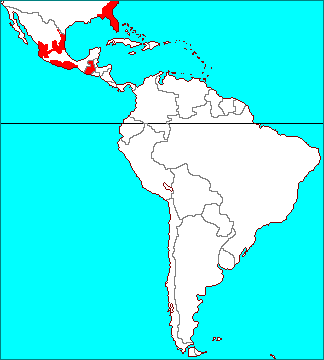
United States, México, Guatemala
United States (State of Florida, South Carolina, southern Georgia)
México (Nayarit, Jalisco, Guerrero, Oaxaca, San Luis Potosí, Tamaulipas)
Guatemala
50 - 2,100 m elevation
Epiphytic on deciduous and shrub forests. Shaded places, occationally sunny places.
Tillandsia bartramii
Tillandsia (Tillandsia) bartramii Elliott (1817)
- [ Etymology ] William Bartram (1739 - 1823), a botanist
- It resembles Tillandsia simulata but leaves of Tillandsia bartramii are numorous, narrower and straight. On the other hands, leaves of Tillandsia simulata are fewer, wider and recurved.
- Tillandsia bartramii distributes mainly in northern parts of Florida, USA, whereas Tillandsia simulata in southern parts of Florida.
- [ Width ] 19 - 32 cm
- [ Height ] 18 cm, Flowering 19 - 21 cm
- [ Petal ] Violet C60 M70 Y0 K0
- [ Bract ] Red C20 M50 Y30 K0
- [ Flower ] March, July
- [ Flower ] for 29 days
Classification
- [ Genus ] Tillandsia
- [ Subgenus ] Tillandsia
- [ Species ] bartramii
- [ Synonyms ]
- Bartram's airplant
- Tillandsia juncea sensu Le Conte
- Tillandsia myriophylla Small (1933)
- Tillandsia pinifolia Leconte (1828)
Cultivation
Informations summarized here are based on our experiences, and TrekGEO does not guarantee the results by cultivating in the same or similar conditions described here. Even a species of Tillandsia differs substantially between individuals, and is very sensitive in changes of environments. Applicatons of any idea inspired by this site should be at your own risks.
4th Plant
- Cultivation condition
- Partial sun, Dipping, Shelving, AC / Heater
- May 2025 It keeps growing.
- Nov 2024 Capsules opened and seeds were scattered.
- May 2024 2 capsules began to grow.
- Mar 2024 It flowered.
- Dec 2023 An inflorescence began to grow from the largest foliage of the clump.
- Aug 2023 Roots began to grow.
- Up to this point
- Partial sun, Long soaking, Shelving, AC / Heater
- Nov 2021 It keeps growing.
- Up to this point
- Partial shade, Long soaking, Shelving, Summer AC
- Apr 2020 It keeps growing.
- Nov 2019 Good condition. It was labeled as Tillandsia chaetophylla.
3rd Plant
- Cultivation condition
- Partial sun, Dipping, Shelving, AC / Heater
- May 2025 It keeps growing.
- Aug 2023 Roots began to grow.
- Aug 2022 Foliages flowered in 2019 died and were removed.
- Up to this point
- Partial sun, Long soaking, Shelving, AC / Heater
- Nov 2021 It keeps growing.
- Up to this point
- Partial shade, Long soaking, Shelving, Summer AC
- Apr 2020 It keeps growing.
- Jan 2020 Capsules opened and seeds were scattered.
- Sep 2019 1 - 3 offsets began to grow.
- Aug 2019 2 capsules began to grow. A root began to grow.
- Jun 2019 It flowered.
- Feb 2019 Inflorescences began to grow from 4 foliages of the clump.
- Dec 2018 Good condition.
2nd Plant
- Cultivation condition
- Partial sun, Dipping, Shelving, AC / Heater
- Oct 2025 The capsule opened and seeds were scattered.
- Aug 2025 3 offsets began to grow from the bottom of the foliage.
- May 2025 Capsules began to grow.
- Mar 2025 It flowered.
- Nov 2024 An inflorescence began to grow.
- Up to this point
- Partial sun, Long soaking, Shelving, AC / Heater
- Nov 2021 It keeps growing.
- Up to this point
- Partial shade, Long soaking, Shelving, Summer AC
- Apr 2020 It keeps growing.
- Jul 2019 Roots began to grow.
- Jun 2018 Many roots began to grow.
- May 2017 Good condition.
1st Plant
- Cultivation condition
- Partial shade, Long soaking, Shelving, Indoors
- Jul 2008 Roots began to grow.
- Jul 2007 Roots began to grow.
- Oct 2006 Moved to another site. Cultivation condition is almost same as the previous site.
- Oct 2006 The original foliage had died and removed.
- Sep 2006 The original foliage began to die. The offset has grown up to the same size as the flowered foliage.
- Sep 2004 Roots began to grow.
- Aug 2004 The temperature rises above 30 degree C for 40 days, and the highest temperature was over 39 degree C.
- May 2004 Offsets began to grow.
- Mar 2004 The capules was opened and seeds were scattered.
- Nov 2003 Capsules began to grow.
- Jun 2003 It flowered.